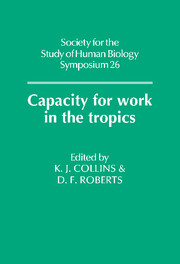Book contents
- Frontmatter
- Contents
- Preface
- Measurement of Working Capacity in Populations
- Functional Consequences of Malnutrition
- Growth, Stature and Muscular Efficiency
- Growth, stature and fitness of children in tropical areas
- Ethnic and Socio-Cultural Differences in Working Capacity
- Energy Expenditure and Endemic Disease
- Research Models in Tropical Ecosystems
- Index
Growth, stature and fitness of children in tropical areas
Published online by Cambridge University Press: 15 March 2010
- Frontmatter
- Contents
- Preface
- Measurement of Working Capacity in Populations
- Functional Consequences of Malnutrition
- Growth, Stature and Muscular Efficiency
- Growth, stature and fitness of children in tropical areas
- Ethnic and Socio-Cultural Differences in Working Capacity
- Energy Expenditure and Endemic Disease
- Research Models in Tropical Ecosystems
- Index
Summary
INTRODUCTION
Human variability (at adulthood as well as during growth) is greater in the tropics than in any other part of the world. Male adult sizes of almost 185 cm (the Nuer of South Sudan, according to Twiesselman, 1965) or below 145 cm (the Efe and Bambuti of the Ituri forest: 144 cm, according to Gusinde, 1948) have been reported. Such large differences have to be ascribed clearly as much to genetic as to environmental factors, and should show up during growth: genetic, because it is difficult to attribute differences of more than 30% in adult stature exclusively to environmental factors thwarting the genetic potential; environmental, certainly, because it is clear that in this vast region the interplay of environmental factors influence the physical development towards adult size as in no other part of the world.
Genetic factors will have to do with long-range adaptation to the environment. Hiernaux (1977) explains the small size of the pygmy as a gradual adaptation to the heat and moisture of the rain forest: taking a north to south gradient of increasing humidity, he ascribes the difference in size between the Sara of South Tchad, the Tomba and the Twa of the equatorial region in Zaire, in terms of a genetic answer to the problem of thermoregulation. Broadly speaking, this theory holds. However, following a west-to-east gradient along the equator, one encounters decreasing humidity and temperatures, going from the Lake Tumba region of the Twa, whose adult males stand 159 cm (Ghesquiere & Andersen, 1970) to the Ituri-forest of the Bambuti, who stand only 144 cm (Gusinde, 1944; confirmed later).
- Type
- Chapter
- Information
- Capacity for Work in the Tropics , pp. 165 - 180Publisher: Cambridge University PressPrint publication year: 1988
- 3
- Cited by

